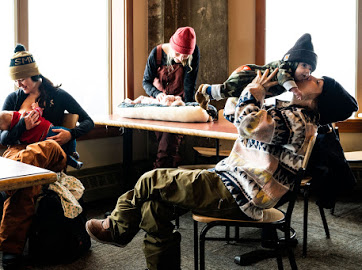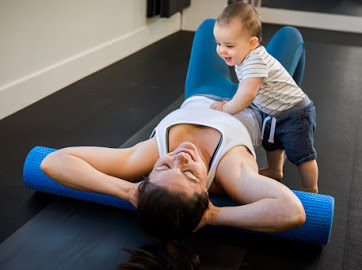Guest blog by Sara Niblock
While pregnant with my son, I put a rigid plan in place for regaining my fitness post-baby. What can I say? I missed my pre-pregnancy body and fitness. I couldn’t wait to get back to my active life. What I didn’t realize is that I have no control over how giving birth will affect my body. Reality hit me quickly after delivering by emergency c-section. There are so many variables that can extend that runway to recovery. A C-section specifically requires a lot of rehabilitation. I felt so weak.
On top of the c-section and the lack of core, I was in pain, extremely emotional/hormonal and sleep deprived. It wasn’t until I started talking to other moms that I discovered that I wasn’t alone. Despite being fit during pregnancy; my loss of core, pelvic pain/pressure, poor posture, an achy body, general fogginess and extreme fatigue can take new moms (like me!) by surprise. It’s hard to fully comprehend until you experience it yourself.

To get back into shape postpartum, new moms need to be realistic, patient and consistent. It took about nine months to create the pregnant body and it often takes just as long to fully return to your pre-pregnancy self. It doesn’t matter if your labor was fast, long, or surgical, the body undergoes a massive transformation to birth a baby. There it is, you have permission to not rush. Remove ‘bounce back’ from your vocabulary.
It’s true, everyone is unique. You might respond to certain exercises differently than other moms. That’s ok. Part of the recovery process is about syncing up with your own body, learning what to look for and feel for to tell if a certain exercise is safe for you.

Let’s Start Here:
Begin with small walks. Just five minutes to see how you feel. If nothing bleeds, pulls, or feels painful, increase the time by a couple of minutes the next day. Progress from there. Please, don’t carry your baby in a front carrier or even push him/her in a stroller for the first couple of weeks (longer with a C-section). The load may be too much on your pelvic floor and core. Wait until you’ve regained control of these areas first. You’ll thank me later!
Breathwork Pregnancy affects your breathing pattern and believe it or not, to get your core functioning again you’ll need to start with breathwork. You can start practising what’s known as 360 Breathing right away. Lay down, place one hand on your belly and one on your ribs and breath into them. I’ve actually written a handy little guide here.
Add Mobility and Stretching
When you feel ready for more, add in some mobility and stretching to aid your posture. Your body is going to feel sore and achy from all the picking up, feeding, sitting and holding of that cute baby. Gentle movement and stretching exercises will help improve your posture and open up those tight postpartum hips. Try these “Postpartum Essential Mobility”exercises in a video I just posted.

Connect Breath with Deep Core Engagement
Next, start connecting your breath and deep core engagement with gentle fundamental movements like hip lifts and mini-body weighted squats. This is going to help you gain strength in your core, pelvic floor and hips. The ability to coordinate your breath and core with movement will prepare you for bigger movements. How your body reacts will determine how to progress and load exercises going forward. It’s here at around six weeks postpartum that I recommend all moms go see a pelvic floor physiotherapist.
Perfect everyday movements. These are functional movements like the million squats and hinge motions associated with picking up your baby, the toys and sitting down into a chair. It’s important to do them correctly from the start to reinforce proper movement patterns.
Tips For A+ Functional Movements:
– Move from the hips first, then bend at the knees to lower down.
– Coordinate your breath so that you’re exhaling on exertion to activate the core or through the whole movement if you need more support.After birth you need to retrain these patterns because your new postpartum body will try to compensate.
– Practise every time you get in and out of a chair or bend down to pick something up.
– Once the foundation is set, in other words your breath, pelvic floor and deep core are working together you can progressively strengthen the rest of the body.
-Keep in mind that the intensity of your activities should be a progression.
These four “P”s can help you check in with yourself. Is there…
–
– Pressure/heaviness in the vagina?
– Peeing or leaking of any amount?
– Peaking or doming of the abdominals?
These are all signs that the exercise needs to be modified and if symptoms persist you need to seek out professional help. I suggest visiting a pelvic floor physiotherapist to get a proper assessment and then working alongside a Postpartum Corrective Exercise Specialist or joining a postpartum fitness specific program like Mountain Mom Strong.

Lastly, be mindful of how you feel.
– Your body needs rest, recovery and a progressive return to fitness. A couple of quick facts to live by as a new mom: Healing and recovery are slowed down when you are getting less than seven hours of sleep a night.
– Eating healthy and fueling your body with whole foods can help with recovery and rebuilding your strength. Don’t even think about dieting or losing weight right now. If you’re breastfeeding you need five hundred more calories a day, so eat healthy and eat enough.
– When breastfeeding the hormone “Relaxin” is still present. As you may remember from pregnancy, Relixin makes your joints more lax. This may or may not affect you, but something to be mindful of when adding in high impact exercises to activities.
– Slow is fast. You need to change your mindset postpartum. Going too fast too soon could lead to pelvic dysfunction like prolapse, diastasis recti not improving, injuries and or sets backs.
– It’s recommended to begin with low impact exercises and not resume high impact activity before twelve weeks postpartum.
– Take the time now to truly heal and strengthen your body. To not only return to what makes you, you but to feel strong enough to handle the everyday tasks associated with being a mom. This means you’ll likely minimize future back pain, pelvic symptoms and related injuries.
Ready?
Aimed at kicking the postpartum-fitness-guesswork to the curb, I’ve developed Mountain Mom Strong. If you’ve made it this far in the article you’ll know that I’m dedicated to helping moms rebuild from the inside out. The goal is total body strengthening. If you’re ready to get started, check us out here.








